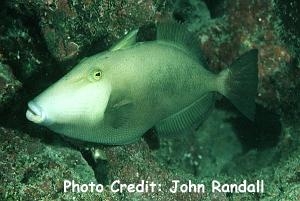
By Bob Goemans


Not Reef Tank Suitable
Likely Fish-Only Tank Suitable
These fishes belong in the Order Tetraodontiformes and Suborder Tetraodontoidei as members of the Family Balistidae (Triggerfishes), which include 12 genera and 40 species with few suitable for the average home aquarium. Like angelfish and surgeonfish, they have laterally compressed bodies and small mouths, but have strong jaws and chisel-like teeth for crushing hard-shelled prey. Their scales are plate-like and have no pelvic fins, however, there is a pelvic spine. And there are three dorsal spines; yet, in some species the third spine is underdeveloped. They are carnivores and their diet consists mainly of small fish, starfish, crabs, shrimp, snails, and are especially fond of urchins, which makes them a 'fish-only' aquarium inhabitant, or at least one without urchins!
Their head often takes up a third of their body length and contains well-developed and independently moveable eyes, which are set high up on their body to protect them from urchin spines. In fact, besides being very capable at breaking off urchin spines so as to get to the central meaty body area, they are also capable of expelling a jet of water from their mouth to turnover urchins so they can get at their soft underbelly! In aquaria, should their diet be inadequate, they tend to lose their vivid colors; yet will normally be paler when resting during nighttime hours. They should be housed with small pieces of seashells on the sand bed surface since they like to bite on them or turn them over in the search of prey. Better these shells being their 'toys' than other aquarium decor! And besides, it helps keep their teeth worn-down, which actually could get too long and pointed and cause them some difficulty in feeding.
Their common name comes from their ability to lock and unlock their first dorsal fin. This fin is normally retracted and carried in a groove on the upper body. When frightened, the fish will dart into a crevice or branch of coral and raise this trigger-like fin, securely locking itself into its place of protection. This first raised and locked spine can only be released when the second spine is depressed into its recess. Normally, they rest at night on rock ledges, amongst coral branches and/or in caves and crevices. They also have a unique form of swimming where the anal and dorsal fins are used for most of their movement; nevertheless, when bursts of speed are needed they use rapid movements of the tail.
These fishes appear to be quite intelligent besides being very hardy and beautiful, however, most are quite pugnacious and some have been known to attack divers when they got too close to their territory. Most are better kept with large moray eels, snappers, angelfish, and tangs, as they cannot be trusted with smaller tankmates. Definitely a fish with a personality!